lower ryalls
lower ryalls
A field in the great Middle Field
Eastland Road has been around, primarily nothing more than a field access track in the lower part of Kingston Manor's great manorial Middle Field, for centuries but has only recently acquired its present name.
The 1589 Terrier in describing Middle Field refers to ".... Alice Haines and John Francis Closes upon Ryalls...." and also makes reference to ".... Wm Jennings in Ryalls...." The 1633 Survey of Kingston recorded that John Symes held "two tenements, 2 half tenements, a cottage and barn, 2 gardens, 3 orchards 8 acres, 2 closes of pasture 14 aces, one of which is called Ryalles."
In his will of 1753, Yeovil butcher Thomas Francis wrote "I give devise and bequeath all those three Closes called Ryalls which I lately purchased of George Davy situate lying and being in Yeovil aforesaid unto my Son Thomas Francis and his Heirs and Assigns for ever".
Between the 1760s and the 1790s wealthy glove manufacturer John Ryall had a glove factory in the area and the lane was known as Ryall's Lane and is shown as such on Watt's map of 1806 which also shows Ryall's Yard in Ryalls Lane. By the time of the 1841 census the lane was known as Kiddle's Lane after glove manufacturers John and William Kiddle who were active in the 1840s and 1850s. The field names of both Higher and Lower Ryalls are clearly based on the Ryall family name but were also known as 'Royal'.
Lower Ryalls had previously been called West Ryalls or West Royals.
As seen on the Tithe Map of 1842 below the track ended roughly where today's Eastland Road crosses Gordon Road and on the eastern side of the track, from this point back to today's Mount Pleasant joins Eastland Road was the field called Lower Ryalls.
An indenture in my collection dated 8 April 1806 shows Samuel Isaac to have leased two fields from John Newman of Barwick for five shillings a year. By the 1840s Samuel Isaac owned both fields. The land in question was "All those two closes of Meadow or Pasture Ground called East Ryalls and West Ryalls otherwise East Royals and West Royals containing by Estimation Fifteen Acres (be the same more or less) bounded on the East by the Highway (today's St Michael's Avenue) leading from Gore Knapp to a place called Newman's plot and on the West by Ryalls Lane (today's Eastland Road) situate lying and being in the parish of Yeovil aforesaid and now or late in the occupation of Thomas Bullock as Tenant thereof to the said John Newman and which said Lands were formerly the Inheritance of John Newman Deceased Grandfather of the said John Newman party hereto and on his decease descended unto his Eldest Son John Newman Father of the said John Newman party hereto and were in and by the last Will and Testament of the said John Newman the son devised unto the said John Newman party hereto in Fee Simple....".
By the time of the 1842 Tithe Map these two fields had been subdivided into the following parcels -
West Ryalls
divided into -
995 Lower Ryalls - leased to Charles Marsh
996 Lower Ryalls - sold to Ann Collins
East Ryalls
divided into -
998 In Marle Close - sold to John Tanner Whiteley Pitcher
999 Higher Ryalls - leased to Charles Marsh
1005
Higher Ryalls -
sold to
Ann
Collins
The 1846 Tithe Apportionment notes both parcels of Lower Ryalls as pasture (that is, grazing land for cattle, horses, etc.). At this time Parcel 995 was owned by Samuel Isaac and occupied by Charles Marsh. It was noted as pasture and measured 4a 3r 0p.
By 1846 Samuel Isaac had sold Parcel 996 to Ann Collins and it was occupied by James Squire. It was noted as pasture and measured 1a 3r 26p.
Therefore, from the above, owners of West Ryalls / Lower Ryalls were -
John Newman of
Barwick (c1680 -
bef1790) owner
John Newman of
Barwick
(1717-1799)
owner
John Newman of
Barwick
(c1773-1855)
owner, Thomas
Bullock tenant
Samuel Isaac
(1783-1849)
lessee then
owner
divided into two parcels during this ownership
Parcel 995 - Samuel Isaac owner, Charles Marsh
tenant
Sold by Samuel's
brother Thomas
on the death of
Samuel.
Parcel 996 - Ann Collins owner, James Squire
tenant
In the late nineteenth century Mount Pleasant was built along the southern boundary of Lower Ryalls. Today the former Lower Ryalls is the site of Mount Pleasant, part of Eastland Road (from Mount Pleasant to North Terrace), part of Gordon Road (between Mount Pleasant and Eastland Road), Smith's Terrace and North Terrace. To the north, Lower Ryalls extended as far as today's Fielding Road.
![]()
Many thanks to Sara and Michael Grint for giving me access to their original house deeds thereby allowing me to piece together the following somewhat complex history of the ownership of Lower Ryalls after the time of Samuel Isaac and the land that Mount Pleasant Terrace was ultimately built on -
By 1866 Lower Ryalls was owned by Joseph Dimmock and in this year he sold it to Charles Blake who, in turn, sold it to Henry Cole. Previously Stephen Harris had contracted with Blake for the purchase of a portion of the land including any buildings, etc. on it. However it appears that Harris couldn't raise all the necessary capital and in 1867 borrowed a sum of money from from coal and timber merchant (and later Mayor of Yeovil) Jabez Bradford on the security of the land in order to pay Cole.
In 1868 a financial agreement (basically a mortgage) was made between Henry Cole, Stephen Harris and brothers and Yeovil solicitors Thomas Moore and Joseph Chaffey Moore at which time further monies were borrowed by Harris and (I think) Cole was finally paid off.
In order to pay of his debts owed on the land, in 1868 Harris sold part of the land to William Jackson and George Armstrong. By 1879 further portions of land had been sold to Samuel Trask, James Lucas and Aaron Partridge. By October 1879, still owing substantial sums of monies plus mounting interest, it appears that Harris finally sold the remaining land to the Moore brothers for the sum of £5.
In 1884 the Moore brothers sold the corner plot of land (shaded pink in the map below) to Lyndall Pomeroy, who built the first two houses in Mount Pleasant. In 1886 Lyndall Pomeroy sold the portion of land and the two houses he had built thereon to his father Henry Pomeroy.
Lyndall's parents, Henry and Louisa, together with Lyndall's brother Frederick lived in No 1 while the other, No 3, was rented out. Lyndall's father, Henry, died in 1904 and his estate was valued at £2,031 (about £1,150,000 at today's value). On his death title of the properties reverted to Lyndall Pomeroy. By 1911 Lyndall had moved his family to Mudford where the census recorded him as a retired builder. In 1918 he was living in West Coker.
By 1918 the two houses were occupied by the Sutton and Rose families and at this time Lyndall sold the properties to his son Lyndall Henry James Pomeroy.
maps
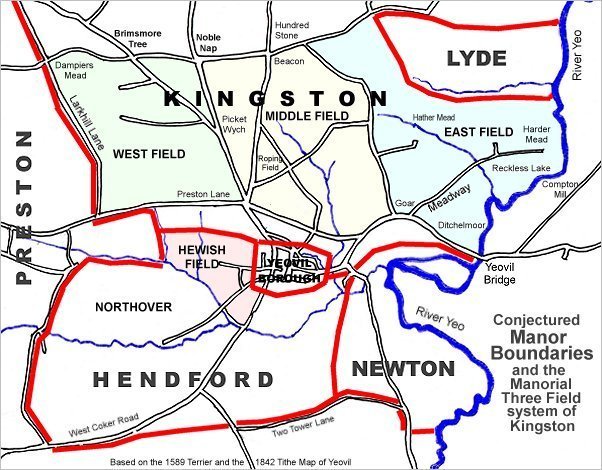
This map, based on the descriptions in the 1589 Terrier and the 1846 Tithe Map of Yeovil shows the approximate boundaries of the Manors of Kingston and Hendford as well as the manorial three-field system used in Kingston.
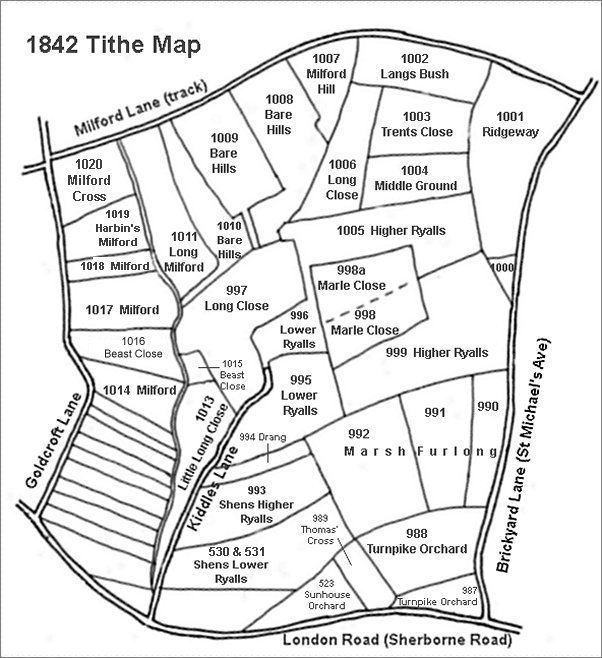
This map is based on the 1842 Tithe Map with field names added from the 1846 Tithe Award.
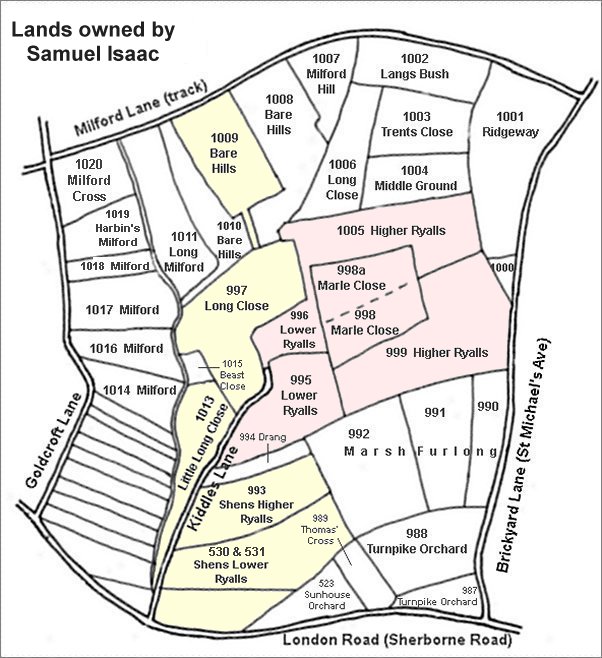
The area shaded pink are the former East Ryalls and West Ryalls leased in 1806, but later owned by, Samuel Isaac. The areas shaded yellow are other parcels owned by him although by 1842 he had sold off Parcels 996 and 1005 to Ann Collins and Parcels 998 and 998a to John Tanner Whiteley Pitcher. Samuel Isaac also owned several other parcels outside this map.
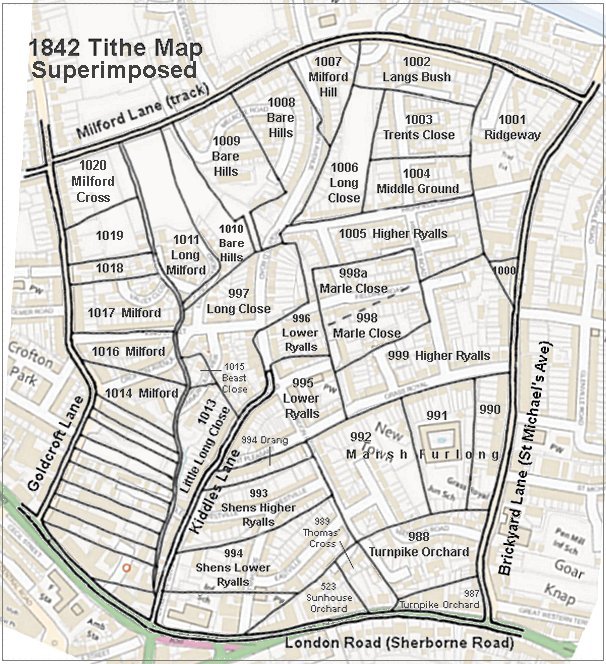
The 1842 Tithe Map superimposed (roughly) over a modern street map showing where several modern roads, for example Gordon Road, Grass Royal and Highfield Road, follow former field boundaries.
gallery
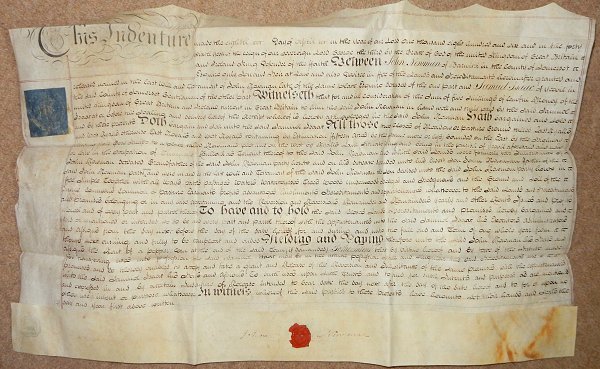
From my
collection
An indenture dated 8 April 1806 in which Samuel Isaac leases East and West Ryalls from John Newman Esq of Barwick. By the 1840s Samuel owned the land outright.
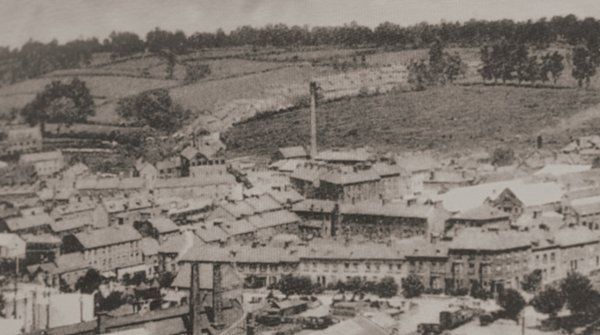
It wasn't all that long ago that there were more fields than houses in Yeovil. Lower Ryalls (995) is the field left of top centre immediately behind the houses and seen to the immediate left of the top of the factory chimney. Lower Ryalls (996) is the smaller field above and to the left with two trees partially obscuring it.
This photograph dates to about 1900 and shows, at centre, the chimney of the Eastland Road brickworks with its associated buildings clustered around its base. To its left is the leather works built by William Bide (recogniseable by the double roof with a row of six black windows). Running along the bottom of the photograph is Station Road with the Alexandra Hotel at bottom right. In the top half of the photo, Eastland Road runs behind the chimney with fields either side!!!